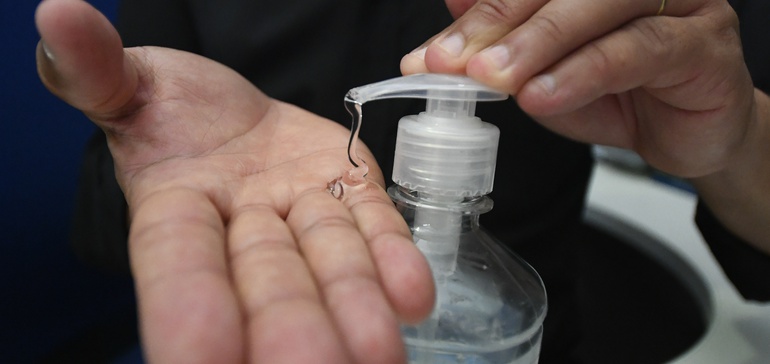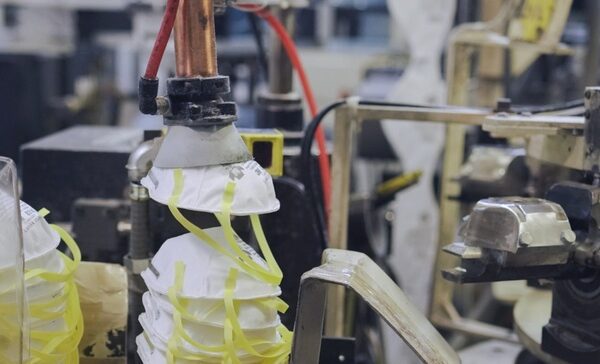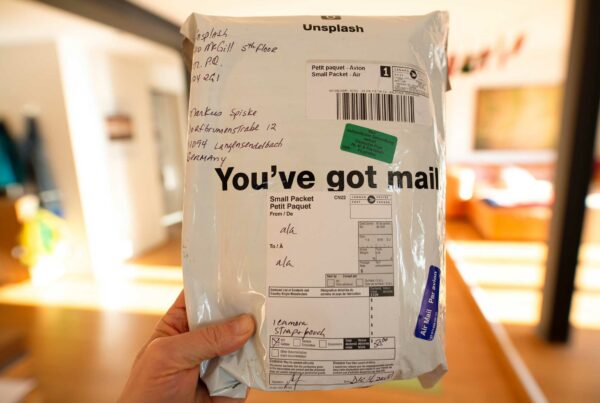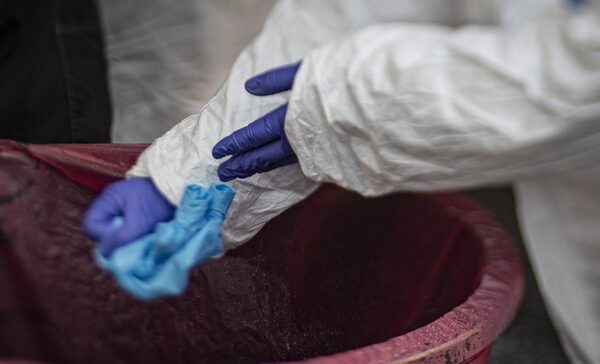
Raw material inputs for hand sanitizer were plentiful. But manufacturing capabilities, government regulations, packaging, and tankers are a different story.
As Red River Biorefinery plotted its April opening, it planned to produce 16.5 million gallons of ethanol (ethyl alcohol) annually to sell as a fuel additive. Some might say the timing couldn’t have been worse, with COVID-19 stay-at-home orders spreading across the country.
“We weren’t driving, so our industry went down to about 50% production capacity,” said Kelly Davis, vice president of regulatory affairs for the Renewable Fuels Association.
If less ethanol is needed for fuel, theoretically plenty should be available for other essential goods, like disinfecting agents and hand sanitizer. After all, manufacturing capacity was idle, and the raw materials were plentiful, with about 40% of corn grown in the U.S. used for biofuel production. Red River’s raw materials, aggregated food byproducts like potatoes, pasta, and sugar beet waste, were available as well.
Capacity, however, assumes that government regulations are aligned with manufacturing capabilities. And that the supply chain is ready to change gears from hauling tankers full of fuel additives to tankers full of higher-grade ethanol. It also assumes that bottling and additional hand sanitizer ingredients are readily available in sufficient quantities.

*Red River and other refineries scrambled to change their manufacturing operations so they could produce higher quality ethanol for hand sanitizers – a product that became as scarce as toilet paper and personal protective equipment. Hand sanitizer sales jumped 470% the first week of March, per Nielsen data.
The RFA and other stakeholders began meeting with the Food and Drug Administration to determine how to fulfill the pandemic needs for this antiseptic ingredient.
“I don’t think I ever worked harder than on this issue,” Davis said.
From a fuel market to a sanitizer market
Ethanol is a big industry in the U.S., with 190 ethanol refineries operational and churning out 16 billion gallons a year.
Most of that is for fuel. “Fuel is what we do. It’s why we’re here,” Davis said. “We’re a 16 billion-gallon market. Plants are scaled to run at that level.”
Ethanol is also used for liquor, cleaning products, the medical industry, personal care products, hairspray, cologne and, yes, hand sanitizer. Hand sanitizer is made with 60%-95% ethyl alcohol or isopropanol alcohol.
But raw material supply wasn’t the issue leading to hand sanitizer shortages. Producing ethanol for hand sanitizer requires additional processing beyond manufacturing fuel-grade ethanol. Manufacturers need to install more distillation columns or other purification processes to meet the required level of quality.
Ethanol occurs as a natural process from fermenting sugar with yeast. The fermentation process also produces small amounts of chemical impurities.
One such chemical is acetaldehyde, which was the FDA’s focus in regulating ethanol for hand sanitizer. In higher concentrations, acetaldehyde can irritate the skin, respiratory tract, and mucous membranes, and can also cause cancer.
A series of FDA guidance updates
Pre-pandemic, ethanol used in hand sanitizer was at a purity level of grain-neutral spirits, with low levels of impurities.
“They were so pristinely clean,” Davis said. “We marketed products to that industry that were better than the quality necessary.” That is a stricter, more time-consuming and intensive production process.
The FDA provided several rounds of updated guidance to ethanol refineries, to increase supplies while maintaining safety.
“The FDA locked in on the acetaldehyde issue,” Davis said. In the first guidance, it required less than 10 parts per million acetaldehyde, a low amount, she said. At that level, “it’s considered safe as a human food ingredient – I can eat it,” she said. This slowed production as plants tried to further refine the product to that level.

Nearly 200 ethanol refineries are operational in the U.S. When the pandemic hit, many adjusted operations to produce higher quality ethanol for hand sanitizers.
Fuel-grade ethanol can have higher impurity levels. But the more impurities a manufacturer wants to remove, the more distillation is required, said Keshav Rajpal, president of Red River Biorefinery. Most fuel-grade manufacturers have a set number of distillation columns, where the ethanol is separated from the liquid stillage. “The more time you cycle through the process, the more pure you get,” Rajpal said.
Subsequent rounds of FDA guidance increased the acetaldehyde levels allowed. Refineries were now producing a lot more ethanol for hand sanitizer use, but the acetaldehyde levels were still above the FDA’s targeted numbers.
“We are 16 billion [fuel ethanol] gallons strong and sanitizer only needs a few hundred million. Work with us,” Davis said about the FDA. With Canada’s relaxed standards allowing up to 400 ppm, some U.S. refineries distributed products over the border instead of selling domestically.
“Everybody and his brother is trying to start a [hand sanitizer] business.”
Kelly Davis
Vice president of regulatory affairs for the Renewable Fuels Association
As the FDA continued updating its guidance, spirit distilleries ramped up production.
“Everybody and his brother is trying to start a [hand sanitizer] business,” Davis said.
The Alcohol and Tobacco Tax and Trade Bureau got involved early, allowing distilleries to produce ethanol for this purpose, with separate guidance allowing distillery production through Dec. 31, 2020.
Finally, the fourth version of FDA guidance relaxed the standards enough to stimulate production, Davis said. The agency changed from restricting acetaldehyde at 10 ppm to 50 ppm.
“That allowed a few of the ethanol plants that started early and were getting better to really increase their volumes. That has allowed the [hand sanitizer] market to stabilize,” she said.
A niche product
Hand sanitizer became a niche for smaller, more nimble plants.
“A few of our members commented that they’ll make it through the quarter. The ability to supply hand sanitizer in a timely manner helped them survive,” Davis said.
The FDA allowing acetaldehyde at 50 ppm made the difference. “If it was just 10 ppm, we’d still be short on hand sanitizer,” Davis said. “My phone calls about this are down to two to three per week versus two to three an hour.”
The Red River Biorefinery was built with additional distillation columns so it could produce U.S. Pharmacopeia-grade (USP-grade) ethanol in the future, after the fuel ethanol business was established.
It needed more capital investment to use the additional distillation columns. “You can’t use the same columns to reprocess [ethanol] because they have different boiling points,” Rajpal said.
As the FDA continued updating its guidance, spirit distilleries ramped up production.
“Everybody and his brother is trying to start a [hand sanitizer] business,” Davis said.
The Alcohol and Tobacco Tax and Trade Bureau got involved early, allowing distilleries to produce ethanol for this purpose, with separate guidance allowing distillery production through Dec. 31, 2020.
Finally, the fourth version of FDA guidance relaxed the standards enough to stimulate production, Davis said. The agency changed from restricting acetaldehyde at 10 ppm to 50 ppm.
“That allowed a few of the ethanol plants that started early and were getting better to really increase their volumes. That has allowed the [hand sanitizer] market to stabilize,” she said.

Permission granted by Red River Biorefinery
Though the FDA guidance allowed for some impurities, Red River wanted to produce USP-grade, as this was a market it would stay in for the long run.
“We didn’t want to be reliant on temporary waivers,” Rajpal said. It took three to four months for Red River to start producing USP-grade ethanol.
Red River Biorefinery is a wholesale supplier, and a number of its customers had issues securing hand sanitizer additives and packaging.
For the refinery, “the biggest supply chain issue was finding adequate infrastructure to ship the product,” said Rajpal. It planned to use fuel-grade tankers for transporting ethanol, but USP-grade ethanol needs different chemical-grade trailers to haul the product.
“We had to make sure they were clean and do testing,” Rajpal said. Red River’s partner was going to handle fuel shipping but couldn’t do it for USP-grade ethanol. The refinery had to find alternative transportation providers.
The higher-grade product also required a different quality assurance process. The company trained staff and truck drivers to understand shipping procedures.
“The biggest supply chain issue was finding adequate infrastructure to ship the product.”
Keshav Rajpal
President of Red River Biorefinery
Due to the pandemic, it was easy for Red River to find clients, helping the refinery get into the market faster than it would have otherwise.
“Currently we’re contracting out through 2021 with potential customers. We’re shipping USP product and ramping up production to match sales,” Rajpal said.
Demand isn’t going away, according to Davis. “People are going to use hand sanitizer. It’s been growing annually for years. It’s here to stay.”






